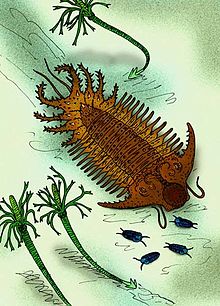| Lichida Temporal range:
| |
|---|---|

| |
| Terataspis grandis | |
| Scientific classification | |
| Domain: | Eukaryota |
| Kingdom: | Animalia |
| Phylum: | Arthropoda |
| Class: | †Trilobita |
| Order: | †Lichida Moore, 1959 |
| Families[1] | |

Lichida is an order of typically spiny trilobite that lived from the Furongian to the Devonian period.[2] These trilobites usually have 8–13 thoracic segments.[1] Their exoskeletons often have a grainy texture or have wart or spine-like tubercles. Some species are extraordinarily spiny, having spiny thoracic segments that are as long or longer than the entire body, from cephalon (head) to pygidium (tail). The sections of the pygidia are leaf-like in shape and also typically end in spines.
The order is divided into two families, Lichidae, and Lichakephalidae.[1] Some experts group the families of the closely related order Odontopleurida within Lichida, too, whereupon the family is then divided into three superfamilies, Dameselloidea, containing the family Damesellidae, Lichoidea, containing the families Lichidae and Lichakephalidae, and Odontopleuroidea, containing the family Odontopleuridae.
Lichids are some of the largest trilobites, with the second and third largest trilobites (Uralichas hispanicus, and Teratapsis grandis) being in the order.[3]
Taxa traditionally placed within Lichida
[edit]
As mentioned earlier, the order Lichida is divided into two families.
Lichidae
[edit]- Acanthopyge
- Akantharges
- Allolichas
- Amphilichas
- Apatolichas
- Arctinurus
- Autoloxolichas
- Borealarges
- Ceratarges
- Conolichas
- Craspedarges
- Dicranogmus
- Dicranopeltis
- Echinolichas
- Eifliarges
- Gaspelichas
- Hemiarges
- Homolichas
- Hoplolichas
- Hoplolichoides
- Jasperia
- Leiolichas
- Lichas
- Lobopyge
- Lyralichas
- Mephiarges
- Metaleiolichas
- Metalichas
- Metopolichas
- Neolichas
- Nipponarges
- Ohleum
- Oinochoe
- Otarozoum
- Paraleiolichas
- Perunaspis
- Platylichas
- Probolichas
- Pseudotupolichas
- Radiolichas
- Richterarges
- Rontrippia
- Terataspis
- Terranovia
- Trimerolichas
- Trochurus
- Uralichas
- Uripes
Lichakephalidae
[edit]Cladogram
[edit]Pollit et. al. (2005) described the internal relationships bellow family level for Lichida.[4]
References
[edit]- ^ a b c S. M. Gon III (January 1, 2008). "Pictorial guide to the order Lichida". Retrieved October 24, 2013.
- ^ H. B. Whittington (2002). "Lichidae (Trilobita): morphology and classification". Journal of Paleontology. 76 (2): 306–320. doi:10.1666/0022-3360(2002)076<0306:LTMAC>2.0.CO;2. JSTOR 1307144.
- ^ "The World's Largest Trilobites".
- ^ Pollitt, J R; Fortey, R A; Wills, M A (2005). "Systematics of the trilobite families Lichidae Hawle & Corda, 1847 and Lichakephalidae Tripp, 1957: The application of Bayesian inference to morphological data". Journal of Systematic Palaeontology. 3 (3): 225–241. doi:10.1017/s1477201905001604. ISSN 1477-2019.
Further reading
[edit]- Margaret J. Campbell & Brian D. E. Chatterton (2009). "Silurian lichid trilobites from northwestern Canada: ontogeny and phylogeny of lichids". Journal of Paleontology. 83 (2): 263–279. Bibcode:2009JPal...83..263C. doi:10.1666/07-140R1.1. S2CID 86082595.
External links
[edit] Data related to Lichida at Wikispecies
Data related to Lichida at Wikispecies